The recreational vehicle industry is flourishing, thanks to folks like Tom Adams, a retired Air Force pilot flying for Southwest Airlines out of Las Vegas, and Elizabeth Fuentes, a construction project coordinator for the city of Henderson. Their contrasting styles are emblematic of the evolving world of RVing.
Adams and his wife, Yong, are in their 50s and cherish their 45-foot-long motor home. It has slide-out walls to accommodate a king-size bed, two bathrooms, leather couches, big-screen TVs, a ducted air-conditioning system, a well-equipped kitchen, washer and dryer, temperature-controlled storage bays and a windshield that’s more like a 4-foot-by-8-foot picture window.
Fuentes, 40 and single, shuns such extravagance. She wants to take advantage of her four-day workweek by traveling around the Southwest in an RV the size of a van that can take her deeper into forests on narrow dirt roads. But she still wants some niceties to provide a glamping (that’s glamour camping, for the uninitiated) experience “with everything I need, including a TV and a clean bathroom.”
Across that spectrum, the RV industry is enjoying an unprecedented eighth consecutive year of growth. Who are these RVers? They love the beauty and solace of being outdoors, abiding by no one’s schedule but their own, favoring two-lane highways over interstates and country stores over suburban malls. They relish wildlife and visiting places of historical prominence, embrace the nighttime quiet and find that friendships with total strangers can be forged over a campfire.
Keep these things in mind
Determine your budget. RVs can be expensive beyond their purchase price. A single tire — and many of these RVs have duallies that should be changed as matched pairs — costs hundreds of dollars. Brace for fuel costs, what with RVs getting roughly between 8 and 15 miles per gallon. Liability insurance is more expensive than what you pay for your car. Like any other homeowner, you’ll inevitably have to repair the plumbing, electrical system and appliances.
Consider campsite fees. Campsites can range from free (many Walmart stores, for example, allow overnight parking as long as you are buttoned up and lay low) to $20 or even $100 a night for commercial campgrounds. The site’s amenities, the size of your vehicle and the day of the week and week of the year determine the price.
Where will you park? When you’re not traveling, you might have trouble parking outside your suburban home or apartment complex. RV storage can cost $50-$200 a month.
Do you need a house sitter? If you travel in your RV most of the time, you’ll want someone to watch over your residence, deal with the mail and care for stay-at-home pets.
Do you have pets? You can take your pets with you, but they will no longer have a yard in which to run; most campgrounds require that animals be penned or on a leash.
Do you need cell service? Many places popular among RVers are off the grid — far from cell towers and TV signals, so you might not be reachable or know what’s happening in the world. Maybe you’ll like that.
Are you weather ready? You will experience bad weather. Fancy the prospect of putting chains on a bus or being buffeted by high winds?
Are you prepared to handle sewage? You will become an expert on how to empty, by hose, the sewage tanks. Remember that if the sensors get dirty, they’ll tell you the tank is full even when it’s not.
Think about the size of your rig and mobility. Depending on rig size, you can’t go some places. Class A motorhomes are banned from many state and national campgrounds because they’re just too big.
RV Lingo
Basement: Storage areas accessible from outside your rig.
Black/gray/city water: Black refers to toilet water; gray, drainage from showers/sinks; and city, drinkable water.
Boondocking: Avoiding established campgrounds to be independent, without using hookups for electricity, water or sewage.
Puller or Pusher: Indicates whether the engine is up front or in the back, as in, “I just bought a 40-foot diesel pusher.”
Shore power: AC power provided by a campsite (or a friend’s garage, if you’re traveling and grabbing a free night in front of the house).
Toad: The vehicle you tow behind your RV.
Toy hauler: A fifth-wheel or travel trailer with a garage at the back to accommodate motorcycles or ATVs. Some campers use the space as a porch.
RVers getting younger
Class B rigs are surging in popularity, says Richard Curtin, a University of Michigan researcher of high-end consumer spending habits. The average age of RV owners has dropped from 48 in 2011 to 45 last year, Curtin says, partly because manufacturers are shaving amenities and prices. “RVers identify with a lifestyle that is tied to a sense of freedom and the outdoors, and can be shared with family and friends,” said Curtin, who sees no downturn in the popularity of RVing.
What’s selling and for how much?
The Recreation Vehicle Industry Association estimates that almost 10 million households own some type of RV. The 430,000 purchased in the U.S. last year (and the range of prices for new RVs) include:
• 282,000 travel trailers: From retro teardrop models that accommodate two people to sleek 35-footers, these are still the most popular vacation rigs. $5,000-$70,000
• 80,400 fifth-wheel trailers: Spacious “fivers,” which look like split-levels hitched to the beds of pickup trucks, tend to stay at a site while the truck explores. $20,000-$100,000+
• 28,000 Class C campers: With the characteristic sleeping compartment over the cab, this boxy option is reminiscent of a U-Haul — but more fun. $50,000-$100,000+
• 22,700 Class A motorhomes: Typically built on a truck or highway bus chassis, these truly are homes on wheels. $100,000-$1 million+
• 4,100 Class B camper vans: The most nimble iteration of the RV, they are best suited for one or two people. $50,000-$125,000.
High-tech trends
Fuel costs can deter prospective owners, so manufacturers have incentive to innovate. Cleaner tech so far has been unable to crack the code for more horsepower to pull all that weight, but other developments are promising:
• Solar power is catching on. Whether it’s panels on RV roofs or small arrays opened at campsites, they allow appliance use without a generator or power hookup. The also can recharge batteries.
• The internet has connected RVers. Scores of websites and Facebook groups offer tips and recommendations on where to dump sewage tanks, which gas stations allow free overnight parking and how to boost a cell signal.
• Those not traveling with a toilet will be relieved to know that the old-fashioned campground pit toilet has largely been replaced by “toilet vaults” — waterless tanks that are emptied periodically and engineered to be virtually odorless.
Postcards from Threemile campground
Yellowstone National Park, the nation’s oldest, brims with RVers. Some avoid the stress of finding a campsite during busy seasons by staying just outside the park.
Threemile Campground, blanketed by chokecherry and rosehip bushes and shrouded beneath the towering lodgepole pines of the Shoshone National Forest, is a favorite. There are no hookups, leaving boondockers to “rough it” at 6,700 feet alongside a rushing river and snow-tipped mountains, with plenty of picnic tables, fire rings and visitation from wildlife. From one night this summer, here’s a sampling of who had settled in:
The young military couple
Ian and Deirdre Strook consider RVing decompression after serving overseas, including in Afghanistan. Married three years, they share their 15-foot, teardrop travel trailer — too short for them to stand erect — with a pair of Chihuahua mixes.
“We had talked about RVing after I retire from the Army in six years, and we started looking at the simple teardrops that open in the back (for cooking) and all you do inside is sleep. Then we found this (better-equipped) one. It was used — 12 years old. No toilet, no gray-water tank. They wanted $4,800. We bought it the next day,” Ian said. “Having been overseas, you get homesick for the United States. There is so much to see! When I retire, we’ll live at home for half the year and RV the other half. We’ll chase the seasons.”
• • •
The retired lady and her mom
Terrie Vaughan, 62, can’t get enough wildlife. She lives in Golden, Colo., and shows photos of the fox and elk that roam behind her house. In a 32-foot motorhome, she takes to the road to view still more forest animals. After buying the rig, she eventually gutted it — putting in wood floors, carpeting and couches that reflect the layout at home — so her blind 87-year-old mother can come along.
Vaughan has logged 52,000 miles on her RV over the past 10 years. She has yet to visit Alaska and New England, but has been to this campground several times. “I come to see the moose, the bears and the damn bison.”
• • •
The great-grandparents
Jim and Sue Hayes, of Salem, Ill., are enjoying the paradox of a 50-year marriage rewarded with retirement: having time to spend with grandchildren and great-grandchildren, while also wanting to spend it by themselves.
“We want to travel the two-lane highways and see average people and the countryside. We want to stop at the flea markets and old country stores and hardware stores. And my bucket list includes going to the Long Branch Saloon in Dodge City (Kan). My wife, she wants to see the largest ball of twine,” Jim said. “We don’t make reservations. I hate to be pressured to be somewhere at a specific time.”
The attraction of RVing
Equipped for spontaneity
At a private, upscale RV resort in Las Vegas, Tom Adams and his wife, Yong, live full-time in their plush, 45-foot, Class A motorcoach, built on the frame of a highway bus. When Tom transfers to another work station — he’s a Southwest Airlines pilot — they’ll disconnect their motorhome from its water, sewage and electrical hookups and hit the highway, the same way they moved here from San jAntonio 11 months ago.
But they have concluded that their coach —with its dishwasher and washer-and-dryer that belie the notion of roughing it — is too big for the kind of camping they want to pursue. So this year they bought a baby RV, a lean 25-foot Class B built on a van chassis. There’s a small dinette behind the driver’s seat, a tidy kitchen with the basics but no frills, cabinets for storage, and a couch that pulls out into a bed in the back, next to a small-but-efficient bathroom with shower.
And now, no country road or vehicle campground is off limits to them. Within the first six weeks of buying it, they drove 3,000 miles, visiting Lake Tahoe, Yosemite and Cedar Breaks National Monument in Utah, among other destinations. They characterize themselves as spontaneous people and relish the ability to easily take off for a weekend without having to unhook the behemoth motorhome.
With the two RVs, Tom is keeping a promise he made when he proposed marriage to Yong in South Korea. An Air Force pilot, he was stationed there, and met her, a civilian worker, on base. RVing is now in their blood, and this brings joy to Yong’s heart. She remembers the proposal 31 years ago: “I agonized between my family and him. I asked Tom, ‘If I marry you, will you show me America?’ He said yes. I already loved him. And now we’re seeing America.”
• • •
Lover of the open road
For Carol White, vacations were car drives to Laguna Beach or San Diego and staying at nice hotels. Driving there was always half the fun. She loved being behind the wheel.
She’s 71 years old, single and working as a casino host at Green Valley Ranch Resort. And she sure hasn’t cut down on her driving. Last year, White, with no RV experience, bought a freshly minted 27-foot motorhome, a Class C, for $62,000. “Good price,” she said.
So why has she forsaken luxury beachfront hotels for hardscrabble campsites at Zion National Park and other outdoor venues where she has to connect sewage lines and deal with critters? “I’ve been staying at hotels all my life, and now I want the freedom to travel when and where I want while being in my own space and sleeping in my own clean bed.
“And I love driving this thing.” Alone? White says she has no concerns as an older woman traveling by herself. “There are good, nice people in campgrounds,” she said.
• • •
Downsizing duo
Harriette and Jay Whitehouse — she’s a born-and-raised Las Vegan, and he’s a Texan — traveled to Alaska by way of British Columbia — a stopping point common among extravagant cruise ships that offer spas, room attendants, casinos, bountiful buffets and optional black-tie dinners. But this was a trip of a different sort, and Harriett was absolutely purring: “Our campground is in one of the most beautiful parks we’ve ever been in. There was no laundromat, no spa, no nothing. Just us and the pine trees and aspen and wildflowers.”
She’s living her dream: To travel full-time in an RV across North America with her husband of 45 years. “We were together for four years before we had kids, and I wanted our time together again,” Harriette said. So now they live in a 35-foot fifth-wheel with slide-outs that allow for large reclining chairs, a well-equipped island kitchen, walk-in pantry, king-size bed, and three big-screen TVs (one mounted for viewing outside) served by a satellite dish. Traveling with them: Tessa, a 9-year-old miniature schnauzer.
They had long been smitten with RVing but got serious as they approached retirement. He was a sign maker, and she worked in the federal bankruptcy court in downtown Las Vegas. “The husband of a friend of mine died suddenly, and it hit me hard. I told Jay that we were retiring, and we needed to start our lives. He agreed.”
They owned three RVs before settling on the one they have now. First came a Class C that worked great with the kids. Then they bought a Class A motorhome, but it was fraught with problems so they got another Class C. Then, to RV full-time, they purchased the more-spacious fifth-wheel and a diesel pickup truck to pull it.
They’ve been on the road since February and will have logged more than 20,000 miles before returning to Henderson for the holidays. On the road, they typically unhook the fifth-wheel and spend several days to up to two weeks at any given campground. They explore an area in their pickup truck during the day. Jay reads and Harriette does bead work in the evening. Once they spent three months at Pismo Beach, Calif. They bank online and get mail forwarded to them by email after the contents are scanned by a mail service outfit in South Dakota.
What came of all the “stuff” they left behind in Green Valley? It’s relegated to a third of a garage bay in the home they’ve turned over to their daughter. “All of our pictures are now in a digital frame,” Harriett said. Most everything else has been, or will be, sold or given away. “The hardest thing to give up was the formal dining room set,” she said.
On the other hand, now they can eat beneath the conifers or alongside the surf.
• • •
The Texas family
For the Ruiz family, from south central Texas, RVing is an annual celebration. They cheerfully introduce themselves: Randall, 44; his wife Amy, 42; and children Michaela, 19; John, 16; and James, 14. Nearby is Randall’s identical twin, Raymond. The teasing starts — who was born first, who’s smarter.
The twins reminisce about camping as kids in the family popup tent trailer; on this trip they are borrowing a relative’s 25-foot travel trailer. Remarkably, they all fit inside.
“It’s not every day you can go outside and see mountains topped with snow in the summer, or go whitewater rafting in cold water and come upon a place that’s quiet and you’re alone,” teenager John says. “Yeah, there are other RVers around us in the campground, but that’s OK. We’re all here for the same reason.”
• • •
The explorers
Dan and Julie Holland, 40 and 38 respectively and parents of a 2-year-old daughter, are in search of America’s finest place to live. They thought they had found it with an idyllic home in a lovely neighborhood in Oakland, Calif., but the software startup Dan was working with failed to launch and reach orbit. They could no longer afford to live there on one paycheck.
But they saw an opportunity. They made a killing selling their home, and bought a new, 27-foot, $80,000 travel trailer. “We had never RVed before,” Julie said. “My mom still thinks we are insane, but we’ve threw our caution to the wind and are traveling around the country to find the best place to live.” They’ve traveled along the West Coast and are now in the Mountain States, heading toward the Midwest.
“We may have already found the perfect place — Gig Harbor, Wash., outside Tacoma, but we promised we would commit to traveling across the country until April.”
They’re surprised how many people live full-time in RVs, and how it’s possible to shed so many belongings and live with so little. Besides, there just isn’t space to keep much, Dan said. “If our daughter throws a few toys on the floor, I stress out. We have to stay on top of that. And the dishes. I miss a dishwasher. And everything has to be stowed when you drive. But I’ve come to like the discipline.”
Said Julie: “Full-time travel can be really exhausting. There’s a lot of planning involved because we’re trying to do serious exploration. We’re not laying in hammocks all day and sipping cocktails. But this all has been positive. We’re spending more time together with our daughter.”
• • •
A family of eight
For all the things that might be seen alongside an RV at a Grand Teton National Park campground — a couple of folding chairs, a barbecue, a satellite dish, maybe a dog — the sight of six children’s bicycles is a stopper. Meet the Brown family — Tom, 46, Brandi, 42, and six kids ages 3 to 17, from a small town near Jacksonville, Fla.
And they’re not on just some family vacation. The’ve been traveling in their 40-foot fifth-wheeler since January. They bought it used — it’s a 2012 — for $25,000, and bought a one-ton pickup truck to pull it, for another $20,000.
What are they up to? Tom loved extended camping trips with his family when he was young. A couple of years ago he, Brandi and the kids went on a 3-week trip in a pop-up tent trailer “and we didn’t want to come home,” he said. “We all wanted to keep seeing more. We all get along, we home-school anyway, and we wanted to show the kids all the places they could go, and see, and experience, and work, and all the people they can meet.”
Daughter Brighton, 17, interjects: “I’m obsessed with history, and to see places and learn the history behind them really enriches the textbook experience.”
Tom has kept his job throughout the travels; he works for an aerospace company with offices throughout the country, so the travels take him to various job sites. This year they’ll drive 3,500 miles.
Advice for others? “You’ve got to be patient. And to be a full-time RVer you really need to adopt a minimalist lifestyle. Otherwise, when you’re taking stuff off the beds and putting them on the floor at night and back on the beds in the morning, it’s an ongoing game of Tetris.”
• • •
Wherever they go is home
Kevin Riley was working at his job in Houston, when he was offered a transfer to Las Vegas. He and his wife, Sharon, had lived in Las Vegas previously and were happy to return. So they hooked up their home — a fifth-wheeler — to their pick-up truck and headed here, first to a campground alongside Interstate 15 and after a few months, relocated to one in Boulder City.
But let’s back up. Their home was a fifth-wheeler in Houston, parked at a commercial campground. He had grown up in a camping family, and Sharon learned to love it as well. So they had purchased, for just more than $100,000, a “fiver” that among other things featured a garage for an ATV, a hobby they enjoyed together. It was comfortable enough to be their home, no matter where Kevin was assigned. He turned the ATV garage into his home office, next to a well-equipped kitchen with dinette table and their master bedroom and roomy bathroom.
“We love the RV lifestyle because of all the options it gives us,” Kevin said. “This resort park is our community, and we’ve met people from all across the country who have become our friends.”
Here, they pay $500 a month for the rent of their RV space; it includes a pool, a clubhouse and most utilities.
“My bosses are jealous,” Kevin says. “We can take off in the fifth-wheel and be tourists — we’ve made a good start in seeing every national park in America — or we can take off on our ATVs by heading out the front gate, turn right and get on the trail.”
Sharon said she had to adjust to an RV lifestyle but has come to love it. “I hate to leave the dogs (Chihuahua mixes Pretzel and Peanut) in a motel room or in a kennel, so they travel with us. And you should see how they react when you stop for the evening and let them out of the truck and they get into the fifth-wheel and they’re so excited to see their home.”


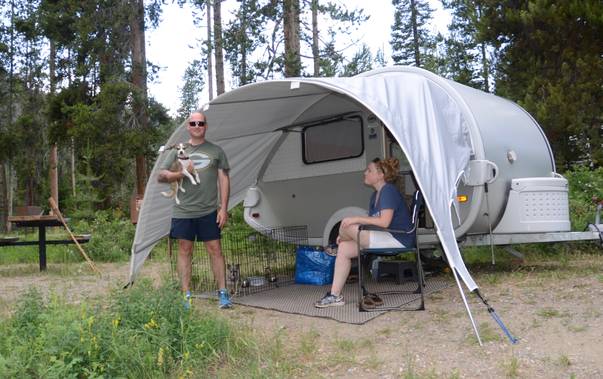
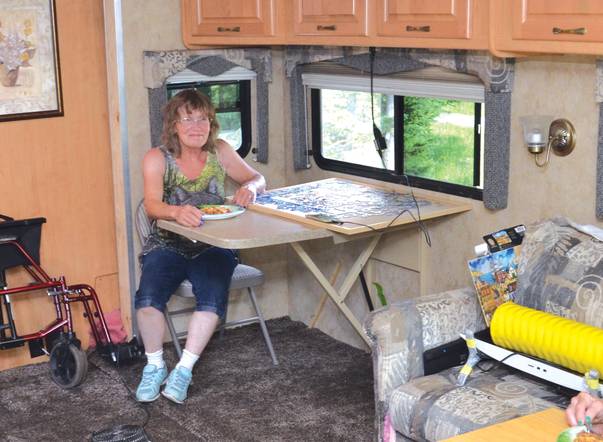
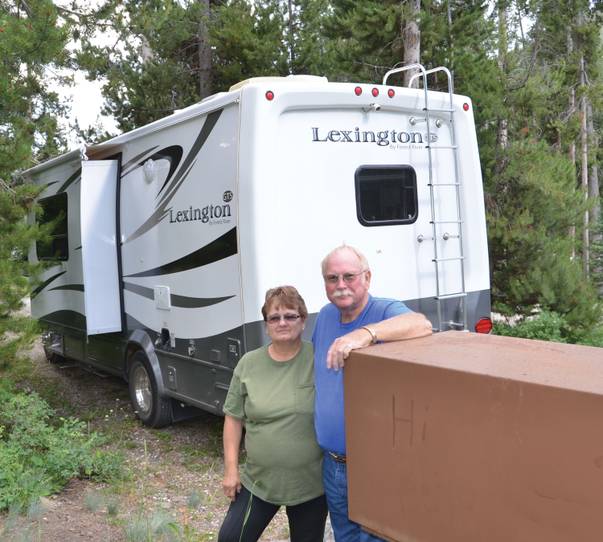

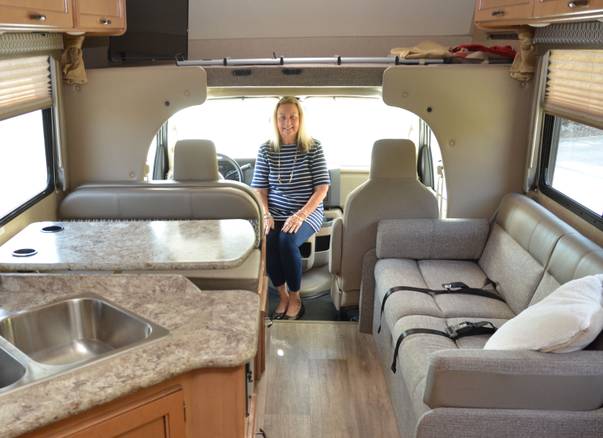
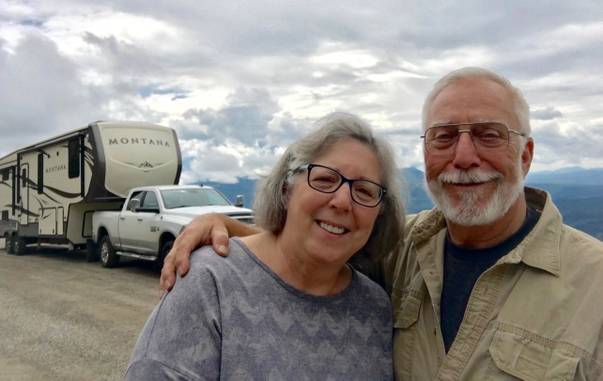
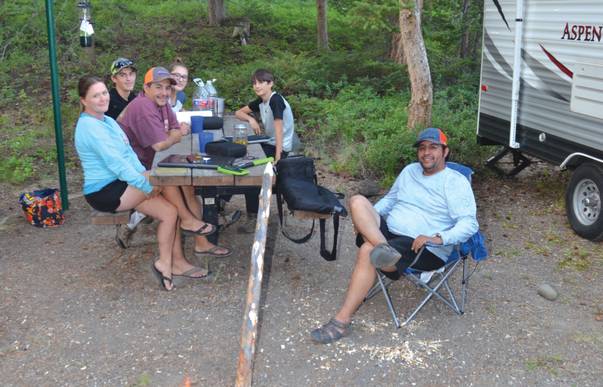
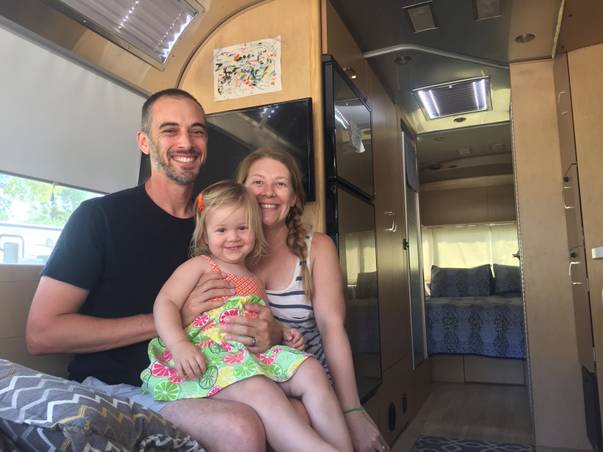
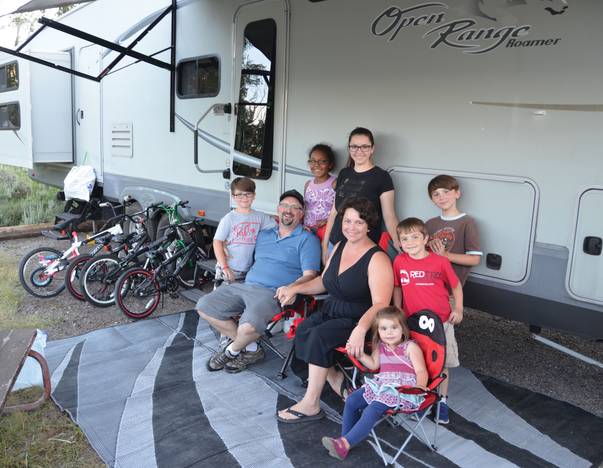

Join the Discussion:
Check this out for a full explanation of our conversion to the LiveFyre commenting system and instructions on how to sign up for an account.
Full comments policy